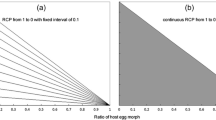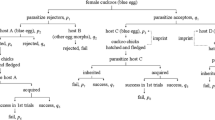Abstract
The common cuckoo Cuculus canorus is a brood parasite that utilizes many host species. These have evolved defense against parasitism to reject cuckoo eggs that look unlike their own and some cuckoos have evolved egg mimicry to counter this defense. Egg phenotype indeed plays a key role for both the cuckoo and its hosts to successfully reproduce. It has been argued that cuckoos should parasitize host nests where egg phenotype matches because this makes parasitism more successful. Details of the cuckoo’s parasitic behavior, however, largely remains unknown if they really parasitize hosts depending on “egg matching”. In this paper, we model a time sequence of parasitic events in which a cuckoo finds host nests and decides to parasitize them or not in the presence of egg polymorphism. We evaluate which strategy is optimal: (1) opportunistic parasitism where cuckoos parasitize hosts irrespective of the phenotype, or (2) non-opportunistic parasitism where cuckoos parasitize hosts where egg phenotype matches. The analysis showed that either of the two strategies can be optimal. Factors not considered in the model, e.g., ecological and evolutionary changes both in the cuckoo and the host side, are discussed to explain apparent contrasts observed in some cuckoo–host interactions.


Similar content being viewed by others
References
Antonov A, Stokke BG, Fossøy F, Ranke PS, Liang W, Yang C, Moksnes A, Shykoff J, Røskaft E (2012) Are cuckoos maximizing egg mimicry by selecting host individuals with better matching egg phenotypes? PLoS ONE 7:e31704. doi:10.1371/journal.pone.0031704
Avilés JM, Stokke BG, Moksnes A, Røskaft E, Åsmul M, Møller AP (2006) Rapid increase in cuckoo egg matching in a recently parasitized reed warbler population. J Evol Biol 19:1901–1910. doi:10.1111/j.1420-9101.2006.01166.x
Birkhead TR, Hemmings N, Spottiswoode CN, Mikulica O, Moskát C, Bán M, Schulze-Hagen K (2011) Internal incubation and early hatching in brood parasitic birds. Proc R Soc Lond B 278:1019–1024
Brooke MD, Davies NB (1988) Egg mimicry by cuckoos Cuculuscanorusin relation to discrimination by hosts. Nature 335:630–632. doi:10.1038/335630a0
Chance EP (1940) The truth about the cuckoo. Country Life, London
Cherry MI, Bennett ATD, Moskát C (2007) Do cuckoos choose nests of great reed warblers on the basis of host egg appearance? J Evol Biol 20:1218–1222. doi:10.1111/j.1420-9101.2007.01308.x
Collias EC (1993) Inheritance of egg-color polymorphism in the village weaver (Ploceuscucullatus). Auk 110:683–692
Davies NB (2000) Cuckoos, cowbirds and other cheats. Poyser, London
Davies NB (2011) Cuckoo adaptations: trickery and tuning. J Zool 284:1–14. doi:10.1111/j.1469-7998.2011.00810.x
Davies NB, Brooke ML (1988) Cuckoos versus reed warblers. Adaptations and counter-adaptations Anim Behav 36:262–284
Gibbs HL, Sorenson MD, Marchetti K, Brooke ML, Davies NB, Nakamura H (2000) Genetic evidence for female host-specific races of the common cuckoo. Nature 407:183–186
Gosler AG, Barnett PR, Reynolds SJ (2000) Inheritance and variation in eggshell patterning in the great tit Parus major. Proc R Soc Lond B 267:2469–2473
Higuchi H (1998) Host use and egg color of Japanese cuckoos. In: Rothstein SI, Robinson SK (eds) Parasitic birds and their hosts: studies in coevolution. Oxford University Press, Oxford, pp 80–93
Honza M, Moksnes A, Røskaft E, Stokke BG (2001) How are different common cuckoo Cuculuscanorus egg morphs maintained? An evaluation of different hypotheses. Ardea 89:341–352
Honza M, Sulc M, Jelínek V, Pozgayová M, Procházka P (2014) Brood parasites lay eggs matching the appearance of host clutches. Proc R Soc Lond B 281(1774):20132665
Kim CH, Yamagishi S, Won PO (1995) Egg-color dimorphism and breeding success in the crow tit (Paradoxornis webbiana). Auk 112:831–839
Kleven O, Moksnes A, Røskaft E, Rudolfsen G, Stokke BG, Honza M (2004) Breeding success of common cuckoos Cuculus canorus parasitising four sympatric species of Acrocephalus warblers. J Avian Biol 35:394–398
Lee JW, Jabłoński PG (2012) Egg color polymorphism and morph-ratio variation in Korean populations of the vinous-throated parrotbill. Chin Birds 3:312–319
Lee JW, Yoo JC (2004) Effect of host egg color dimorphism on interactions between the vinous-throated parrotbill (Paradoxornis webbianus) and common cuckoo (Cuculus canorus). Korean J Biol Sci 8:77–80
Lee JW, Kim DW, Yoo JC (2005) Egg rejection by both male and female vinous-throated parrotbills Paradoxornis webbianus. Integr Biosci 9:211–213
Liang W, Yang C, Antonov A, Fossøy F, Stokke BG, Moksnes A, Røskaft E, Shykoff JA, Møller AP, Takasu F (2012a) Sex roles in egg recognition and egg polymorphism in avian brood parasitism. Behav Ecol 23:397–402. doi:10.1093/beheco/arr203
Liang W, Yang C, Stokke BG, Antonov A, Fossøy F, Vikan JR, Moksnes A, Røskaft E, Shykoff JA, Møkker AP, Takasu F (2012b) Modelling the maintenance of egg polymorphism in avian brood parasites and their hosts. J Evol Biol 25:916–929. doi:10.1111/j.1420-9101.2012.02484.x
Mahler B, Confalonieri VA, Lovette IJ, Reboreda JC (2008) Eggshell spotting in brood parasitic shiny cowbirds (Molothrus bonariensis) is not linked to the female sex chromosome. Behav Ecol Sociobiol 62:1193–1199
Moksnes A, Røskaft E (1995) Egg-morphs and host preference in the common cuckoo (Cuculus canorus): an analysis of cuckoo and host eggs from European museum collections. J Zool 236:625–648. doi:10.1111/j.1469-7998.1995.tb02736.x
Moksnes A, Røskaft E, Braa AT, Korsnes L, Lampe HM, Pedersen HC (1991) Behavioural responses of potential hosts towards artificial cuckoo eggs and dummies. Behaviour 116:64–89
Moksnes A, Røskaft E, Rudolfsen G, Skjelseth S, Stokke BG, Kleven O (2008) Individual female common cuckoos Cuculus canorus lay constant egg types but egg appearance cannot be used to assign eggs to females. J Avian Biol 39:238–241
Morales J, Kim SY, Lobato E, Merino S, Tomás G, Martínez-de la Puente J (2010) On the heritability of blue-green eggshell coloration. J Evol Biol 23:1783–1791
Nakamura H, Miyazawa Y, Kashiwagi K (2005) Behavior of radio-tracked Common Cuckoo females during the breeding season in Japan. Ornithol Sci 4:31–41
Øien IJ, Moksnes A, Røskaft E (1995) Evolution of variation in egg color and marking pattern in European passerines: adaptations in a coevolutionary arms race with the Cuckoo Cuculus canorus. Behav Ecol 6:166–174
Rothstein SI (1975) Evolutionary rates and host defenses against avian brood parasitism. Am Nat 109:161–176
Rothstein SI (1990) A model system for co-evolution: avian brood parasitism. Annu Rev Ecol Syst 21:481–508
Soler M, Soler JJ, Martinez JG, Møller AP (1995) Magpie host manipulation by great spotted cuckoos: evidence for an avian mafia? Evolution 49:770–775
Stokke BG, Moksnes A, Røskaft E (2002) Obligate brood parasites as selective agents for evolution of egg appearance in passerine birds. Evolution 56:199–205
Stokke BG, Takasu F, Moksnes A, Røskaft E (2007) The importance of clutch characteristics and learning for antiparasite adaptations in hosts of avian brood parasites. Evolution 61:2212–2228
Takasu F (2003) Co-evolutionary dynamics of egg appearance in avian brood parasitism. Evol Ecol Res 5:345–362
Takasu F, Moskát C (2011) Modeling the consequence of increased host tolerance toward avian brood parasitism. Popul Ecol 53:187–193
Takasu F, Kawasaki K, Nakamura H, Cohen JE, Shigesada N (1993) Modeling the population dynamics of a cuckoo-host association and the evolution of host defenses. Am Nat 142:819–839
Thorogood R, Davies NB (2013) Reed warbler hosts fine-tune their defenses to track three decades of cuckoo decline. Evolution 67:3545–3555
Yang C, Liang W, Cai Y, Shi S, Takasu F, Møller AP, Anton A, Fossøy F, Moksnes A, Røskaft E, Stokke BG (2010) Coevolution in action: disruptive selection on egg colour in an avian brood parasite and its host. PLoS ONE 5:e10816
Yang C, Liu Y, Zeng L, Liang W (2014) Egg color variation, but not egg rejection behavior, changes in a cuckoo host breeding in the absence of brood parasitism. Ecol Evol 4:2239–2246. doi:10.1002/ece3.1096
Acknowledgments
This work was funded by the National Natural Science Foundation of China (nos. 31071938, 31272328 and 31472013 to WL, and 31260514 to CY), Program for New Century Excellent Talents in University (NCET-13-0761) and JSPS KAKENHI Grant Number 23570026 to FT. The authors have declared that no competing interests exist.
Author information
Authors and Affiliations
Corresponding author
Electronic supplementary material
Below is the link to the electronic supplementary material.
About this article
Cite this article
Liang, W., Yang, C. & Takasu, F. Modeling the cuckoo’s brood parasitic behavior in the presence of egg polymorphism. J Ethol 34, 127–132 (2016). https://doi.org/10.1007/s10164-015-0455-3
Received:
Accepted:
Published:
Issue Date:
DOI: https://doi.org/10.1007/s10164-015-0455-3




